Sharon Smallwood, currently cruising the east coast of Australia with husband Julian, shares her thoughts on budgeting your boating.
Last week our 240-volt inverter blew up. Once upon a time this would have been a temporary setback. Without giving it too much thought we'd most likely have opened our wallets and parted with a reasonable sum of cash to purchase a replacement. Now things have changed. We're not so carefree with our credit cards. When something breaks we first have to ask that all-important question – do we really need it?
Australians have arguably suffered less from the impact of the GFC than some of our foreign cousins. Statistically at least, the population has wisely budgeted more and spent less. As a demographic group, cruisers are somewhat ahead of the game when it comes to knowing how to cut costs. Most of us lead comparatively modest lives that let us work less and play more. Nonetheless we're not immune. Tougher times have meant that even the most frugal among us must now make some adjustments in order to stay afloat.
As I was perusing these thoughts a copy of this month's Cruising Helmsman landed on my lap. An interesting article on “Budgeting your boating” by financier Bruce Vass tops the bill. Bruce's words are particularly pertinent for those who balance boating with life on land. From a long-term cruiser's angle I couldn't agree more with the tips on maintenance. Maintaining your own boat not only saves you money, it teaches you the self-sufficiency you ultimately need.
To add to Bruce's pearls of wisdom I'd like to raise the following points. Firstly, check your boat for chafe. Preventable wear and tear is the enemy of the cruising sailor's bank balance and amounts to unnecessary expenditure. Invest in a good sail repair kit – it's cheaper than a set of brand-new sails (as long as you get that stitch in time!). Fit plastic hose over chafing lines to protect sheets, woodwork and superstructure alike. Stop halyards from slapping. They won't wear out so fast (or annoy the neighbours). Keep a close eye on water and fuel hoses. Secure them away from vibrating engine parts, particularly metal ones. Alternatively wrap them in a larger-diameter section of (split) hose.
While underway, sail with the chafe adversary in mind. Keep mainsails off the spreaders downwind. Likewise, watch out for jibs sheeted in too tight when close-hauled. (They have a nasty habit of rubbing on the shrouds.)
Specific to liveaboards and long-term cruisers are issues about lifestyle. Marinas and moorings are becoming luxuries rather than necessities. More cruisers these days are opting to anchor out. Aboard Brilliant II we limit ourselves to berthing for one just night out of every couple of weeks, although this will change during cyclone season when for obvious reasons safety comes first.
We definitely don't eat out as often as we once did, but a few decent cookbooks have made this negligible. I now actually resent paying restaurant prices for food that's not nearly as good as we enjoy at home. Plus at “Bar Brilliant” we've almost always got the better view!
In some ways the current situation reminds me of stories my parents and grandparents used to tell. Whenever I feel stressed about how to make ends meet, I only have to imagine what wartime rationing must have been like. If our forefathers survived then so can we. I'm sure that somehow we'll sail on through.
How do you save money on your boat? Add your comments below.























